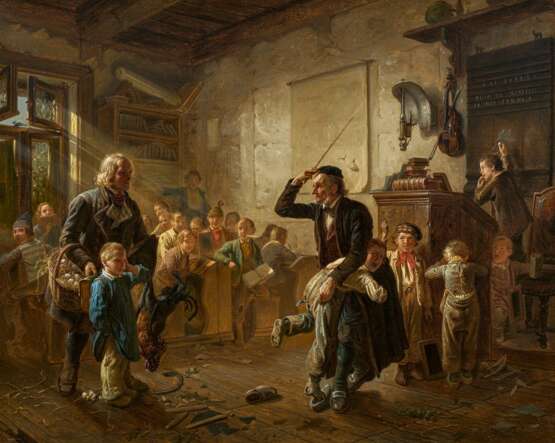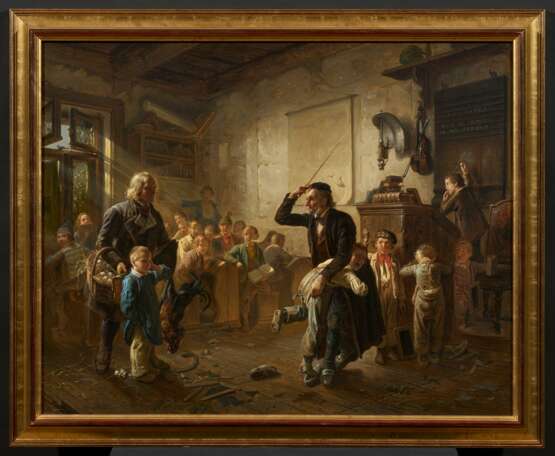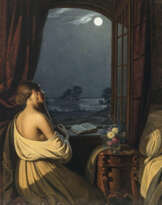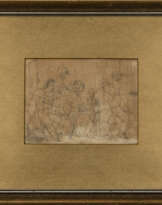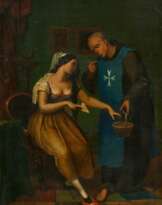ID 842549
Lot 718 | Johann Peters Hasenclever
Estimate value
€ 30 000 – 40 000
Title: "Lasset die Kindlein zu mir kommen" or: The First Day of School.
Technique: Oil on canvas.
Mounting: Relined.
Measurement: 89 x 112cm.
Notation: Signed lower right: J.P. Hasenclever.
Frame: Framed.
Cf. literature:
H. Bestvater-Hasenclever: J.P. Hasenclever. Ein wacher Zeitgenosse des Biedermeier, Recklinghausen 1979, ill. 62: shown here is a lithograph after the theme;
K. Soiné: Johann Peter Hasenclever. Ein Maler im Vormärz, Neustadt 1990, pp. 144ff, cat. rais. no. 237-239: Soigné describes three versions of the theme, a fourth one from 1852 is known later by Galerie Paffrath, Düsseldorf;
Lexikon der Düsseldorfer Malerschule 1819-1918, Munich 1998, p. 59, ill. 42: here depicted a version dated 1852 with slight modifications;
Johann Peter Hasenclever (1810-1853). A Painter's Life between Biedermeier and Revolution. Exhibition Bergisches Museum Schloss Burg an der Wupper, Solingen 04.04.-09.06.2003. cat. no. 112, p. 289f: illustrated and discussed here the version from 1852.
Provenance:
Private ownership, Germany.
A school class that could hardly be imagined any wilder, with a teacher who is overtaxed beyond measure - Johann Peter Hasenclever leads the viewer into a past world that is superficially so clichéd that today, beyond the genre-like narrative, we hardly notice the social criticism that makes the painting a political statement.
Nowadays, Hasenclever is (unfortunately) primarily only associated with his humorous social scenes, which cheerfully recount the everyday life of the Biedermeier era. Even though he is regarded as one of the most important personalities not only of the Düsseldorf School of Painting, but also of 19th century German painting as a whole, he has unjustly been somewhat forgotten, despite his great painterly qualities. In addition to his art, he was also politically engaged during the Vormärz period and was active in the democratic movements during the 1848 revolution, which ultimately failed, however.
His liberal and bourgeois-democratic views are reflected in his paintings and not least in the school scene from 1852 shown here, which is also known under the title "Lasset die Kindlein zu mir kommen" - a title that is clearly meant satirically. The teacher, obviously overwhelmed by the rowdy and wild schoolboys, is punishing a boy with the cane for breaking a blackboard. At that moment, a new pupil is brought into the class by his father, who carries the school fees in the form of eggs and a rooster. In both of them, their shuddering at the situation, as well as the teacher's helplessness and the other pupils' anger at his educational approach are clearly apparent.
This is not the first time that Hasenclever has captured the theme of the first day at school in a painting: there is a known drawing from 1846/47 in which the same situation of introducing a new pupil is depicted. Only here everything is in perfect order, the situation is friendly and trusting. Convinced of the necessity of developing a new educational theory, Hasenclever shows in this pre-Revolutionary drawing a modern and understanding teacher; quite differently in the large painting, in which he humorously depicts the classical schoolmaster of old, and thus what he sees as the retrograde steps of the post-Revolutionary years, during which all educational reforms were reversed. Nevertheless, Hasenclever is and remains the humanist who believes in the good in people: for the light that brings a warm atmosphere to the whole scene comes from the pupils. The painter places his hope in this new generation.
| Artist: | Johann Peter Hasenclever (1810 - 1853) |
|---|---|
| Applied technique: | Oil |
| Auction house category: | Paintings 19th Century |
| Artist: | Johann Peter Hasenclever (1810 - 1853) |
|---|---|
| Applied technique: | Oil |
| Auction house category: | Paintings 19th Century |
| Address of auction |
VAN HAM Kunstauktionen GmbH Hitzelerstr. 2 50968 Köln Germany | ||||||||||||||
|---|---|---|---|---|---|---|---|---|---|---|---|---|---|---|---|
| Preview |
| ||||||||||||||
| Phone | +49 221 92586215 | ||||||||||||||
| Fax | +49 221 92 58 62 4 | ||||||||||||||
| Buyer Premium | 32% | ||||||||||||||
| Conditions of purchase | Conditions of purchase | ||||||||||||||
| Business hours | Business hours
|
